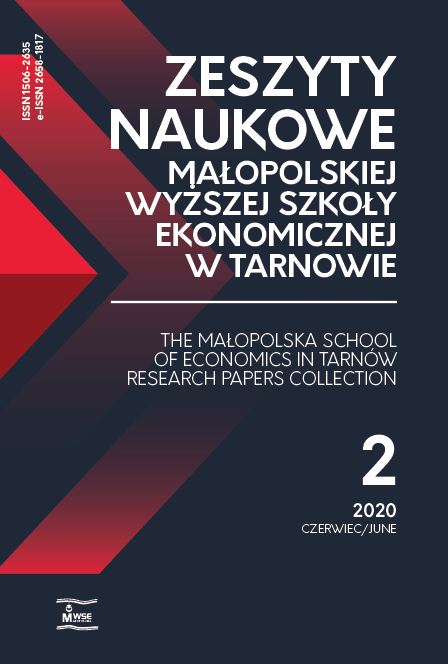Abstract
The return on capital employed, as a financial ratio, is an important element of the assessment of the company’s condition. It shows the benefits gained by company shareholders against the invested capital. It constitutes the basic reason for investing in a particular enterprise. Thus, it is an important diagnostic variable in the construction of a synthetic indicator of the company’s financial standing. The aim of this article is to propose a universal, useful indicator of the profitability of capital which is fully relevant to the formulation of company condition assessment indicators. It is assumed that it should meet the following requirements: firstly, it should reflect the reality, rather than falsify it; and, secondly, it should refer to the return on the entire capital employed. The study has been conducted using the substantive analytical procedure as well as the empirical analysis based on ten companies listed on Warsaw Stock Exchange.
References
Baker, R., Barbu, E. (2007). Trends in research on international accounting harmonization. The International. Journal of Accounting, 42(3), 272–304. DOI: 10.1016/j.intacc.2007.06.003.
View in Google Scholar
Bednarski, L. (2007). Analiza finansowa w przedsiębiorstwie. Warszawa: Polskie Wydawnictwo Ekonomiczne. ISBN 8320816599.
View in Google Scholar
Bednarski, L., Borowiecki, R., Duraj, J., Kurtys, E., Waśniewski, T., Wersty, B. (1996). Analiza ekonomiczna przedsiębiorstwa. Wrocław: Wydawnictwo Akademii Ekonomicznej im. Oskara Langego we Wrocławiu. ISBN 8370112242.
View in Google Scholar
Brennan, M. J., Kraft, H. (2018). Leaning against the wind: Debt financing in the face of adversity. Financial Management, 47(3), 485–518. DOI: 10.1111/fima.12227.
View in Google Scholar
Callen, J. L. (2015). A selective critical review of financial accounting research. Critical Perspectives on Accounting, 26, 157–167. DOI: 10.1016/j.cpa.2013.03.008.
View in Google Scholar
Gabrusewicz, W. (2019). Metody analizy finansowej przedsiębiorstwa. Warszawa: Polskie Wydawnictwo Ekonomiczne. ISBN 9788320823561.
View in Google Scholar
Graham, R. C., King, R. D. (2000). Accounting practices and the market valuation of accounting numbers: Evidence from Indonesia, Korea, Malaysia, the Philippines, Taiwan, and Thailand. The International Journal of Accounting, 35(4), 445–470. DOI: 10.1016/S0020-7063(00)00075-3.
View in Google Scholar
Griffin, P. A., Zhu, N. (2010). Accounting rules? Stock buybacks and Stock options: additional evidence. Journal of Contemporary Accounting and Economics, 6(1), 1–17. DOI: 10.1016/j.jcae.2010.04.001.
View in Google Scholar
GWP. (2013–2020). Giełda Papierów Wartościowych w Warszawie [online, accessed: 2017-12-22; 2018-03-05; 2018-05-15; 2020-04-24]. Retrieved from: www.gpw.pl.
View in Google Scholar
Hopwood, A. G. (2009). The economic crisis and accounting: Implications for the research community. Accounting Organizations and Society, 34(6–7), 797–802. DOI: 10.1016/j.aos.2009.07.004.
View in Google Scholar
Hung, M. (2001). Accounting standards and value revelance of financial statements: An international analysis. Journal of Accounting and Economics, 30(3), 401–420. DOI: 10.1016/S0165-4101(01)00011-8.
View in Google Scholar
Jajuga, K., Jajuga, T. (2015). Inwestycje: instrumenty finansowe, aktywa niefinansowe, ryzyko finansowe, inżynieria finansowa. Warszawa: Wydawnictwo Naukowe PWN. ISBN 9788301149574.
View in Google Scholar
Jerzemowska, M. (ed.). (2004). Analiza ekonomiczna w przedsiębiorstwie. Warszawa: Polskie Wydawnictwo Ekonomiczne. ISBN 8320815096.
View in Google Scholar
Jerzemowska, M. (ed.). (2018). Analiza ekonomiczna w przedsiębiorstwie. Warszawa: Polskie Wydawnictwo Ekonomiczne. ISBN 9788320823080.
View in Google Scholar
King, R. D., Langli, J. C. (1998). Accounting diversity and firm valuation. The International Journal of Accounting, 33(5), 529–567. DOI: 10.1016/S0020-7063(98)90012-7.
View in Google Scholar
Kukuła, K. (1998). Elementy statystyki w zadaniach. Warszawa: Wydawnictwo Naukowe PWN. ISBN 830112458X.
View in Google Scholar
Lainez, J. A., Callao, S. (2000). The effect of accounting diversity on international financial analysis: empirical evidence. The International Journal of Accounting, 35(1), 65–83. DOI: 10.1016/S0020-7063(99)00030-8.
View in Google Scholar
Lisek, S. (2014). Wrażliwość miary syntetycznej na wielkości krytyczne wskaźników służących do jej budowy. Metody Ilościowe w Badaniach Ekonomicznych, 15(4), 71–79.
View in Google Scholar
Lisek, S., Luty, L. (2019). Propozycja wskaźnika atrakcyjności inwestycyjnej przedsiębiorstwa. Wiadomości Statystyczne, 64(4), 49–67.
View in Google Scholar
Łuniewska, M., Tarczyński, W. (2006). Metody wielowymiarowej analizy porównawczej na rynku kapitałowym. Warszawa: Wydawnictwo Naukowe PWN. ISBN 9788301146467.
View in Google Scholar
Nowak, E. (1990). Metody taksonomiczne w klasyfikacji obiektów gospodarczych. Warszawa: Państwowe Wydawnictwo Ekonomiczne. ISBN 8320806895.
View in Google Scholar
Nowak, E. (2017). Analiza sprawozdań finansowych. Warszawa: Polskie Wydawnictwo Ekonomiczne. ISBN 9788320822564.
View in Google Scholar
Palea, V. (2015). The political economy of fair value reporting and the governance of the standards-setting process: Critical issues and pitfalls from a European perspective. Critical Perspectives on Accounting, 29, 11–15. DOI: 10.1016/j.cpa.2014.10.004.
View in Google Scholar
Rueschhoff, N. G., Strupeck, D. (1998). Equity returns: Local GAAP versus U.S. GAAP for foregin issuers from developing countries. The International Journal of Accounting, 33(3), 377–389. DOI: 10.1016/S0020-7063(98)90038-3.
View in Google Scholar
Siemińska, E. (2002). Metody pomiaru i oceny kondycji finansowej przedsiębiorstwa. Toruń: Wydawnictwo Dom Organizatora. ISBN 8372851174.
View in Google Scholar
Sierpińska, M., Jachna, T. (1994). Ocena przedsiębiorstwa według standardów światowych. Warszawa: Wydawnictwo Naukowe PWN. ISBN 8301111879.
View in Google Scholar
Sikka, P. (2015). The hand of accounting and accountancy firms in deepening income and wealth inequalities and the economic crisis: Some evidence. Critical Perspectives on Accounting, 30, 46–62. DOI: 10.1016/j.cpa.2013.02.003.
View in Google Scholar
Soll, J. (2015). The reckoning: Financial accountability and the rise and fall of nations. New York: Basic Books. ISBN 9780465031528.
View in Google Scholar
Sudoł, S. (1999). Przedsiębiorstwo. Podstawy nauki o przedsiębiorstwie. Teorie i praktyka zarządzania. Toruń: Towarzystwo Naukowe Organizacji i Kierownictwa „Dom Organizatora”. ISBN 8387673757.
View in Google Scholar
Tarczyński, W. (2002). Fundamentalny portfel papierów wartościowych. Nowa koncepcja analizy portfelowej. Warszawa: Polskie Wydawnictwo Ekonomiczne. ISBN 8320814235.
View in Google Scholar
Wilkinson, B. R., Durden, C. H. (2015). Inducing structural change in academic accounting research. Critical Perspectives on Accounting, 26, 23–36. DOI: 10.1016/j.cpa.2014.03.002.
View in Google Scholar

This work is licensed under a Creative Commons Attribution-NonCommercial-NoDerivatives 4.0 International License.

